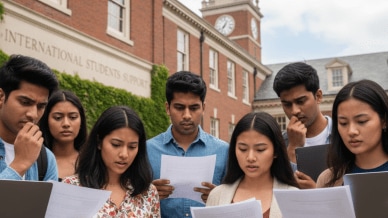Beyond the H-1B Visa: Alternative pathways for students to build a career in US
The appeal of studying at institutions like Harvard, MIT, Yale, or Stanford isn’t just about immigration outcomes. It’s about academic pedigree, global networks, and access to cutting-edge research and industry.

– Saurabh Arora
The H-1B visa is one of the most in-demand US work visas. It gives American companies access to global talent and offers international professionals a chance to work in the United States. Each year, thousands of Indian students travel to the US in pursuit of world-class education and global career opportunities.
For many, the goal is to secure an H-1B visa as a step toward long-term employment after graduation and building a future abroad. But reality isn’t always so straightforward. In the past 2 to 3 years, access to the US job market has become more competitive due to rising demand, strict annual caps, and an unpredictable lottery system.
While an H-1B rejection can be disappointing, it is not the end of the journey. Indian students still have several other options to build strong international careers and make the most of their US education. Here are a few pathways worth exploring:
– Use Optional Practical Training (OPT) and the STEM OPT Extension
After graduation, international students on an F-1 visa are eligible for Optional Practical Training (OPT), which allows them to work in the US for up to 12 months. Those in STEM fields can apply for an additional 24-month STEM OPT extension, giving them up to three years of work experience.
This window can be used to gain real-world experience, strengthen professional networks, and even attempt the H-1B lottery again in future cycles. Many employers prefer hiring candidates who already have work experience, which makes OPT an important stepping stone.
– Consider Cap-Exempt H-1B Opportunities
Most H-1B visas fall under an annual cap of 65,000, with an additional 20,000 reserved for US master’s degree holders. However, some employers are exempt from these limits. Institutions of higher education, affiliated nonprofit organizations, nonprofit research institutions, and government research agencies can sponsor H-1B visas without being subject to the cap.
These cap-exempt roles can be applied for year-round and are not limited by the lottery. Students who explore roles in these sectors can gain US work experience while avoiding some of the uncertainty tied to the traditional H-1B process. While the H-1B is still currently lottery-based, proposed changes are being reviewed that may move it toward a wage-based selection model in the future.
– Pursue Higher Education or Specialized Programs
If an immediate work visa isn’t possible, students may consider enrolling in advanced programs such as a master’s, MBA, or doctoral degree. This not only enhances academic qualifications but also resets their F-1 visa status, giving them another opportunity to apply for OPT and enter the H-1B lottery after graduation.
Higher education at reputed institutions also increases access to internship opportunities, employer networks, and on-campus recruitment programs.
– Look at Intra-Company Transfers Through the L-1 Visa
The L-1 visa allows multinational companies to transfer employees from foreign offices to US locations. A professional working for a company’s office in India can be moved to its US branch under this program.
To be eligible, the employee must have worked with the company outside the US for at least one continuous year within the last three years. The company must also have a qualifying relationship between its US and foreign offices. For students working with global firms, this route can offer a more stable and predictable path to work in the United States.
– Explore the O-1 Visa for Individuals with Extraordinary Ability
The O-1 visa is designed for individuals who demonstrate extraordinary ability in fields such as science, education, business, athletics, or the arts. Some recent graduates with strong professional achievements, publications, or awards may be eligible.
The visa allows an initial stay of up to three years, with possible extensions. While the eligibility criteria are rigorous, it remains a strong alternative for students who have already established a notable track record in their domain.
Staying Proactive and Positive
While countries like Canada and the UK have built reputations for offering more streamlined immigration systems with faster study permits, clearer PR pathways, and more transparent timelines, the US continues to draw students for a different reason.
The appeal of studying at institutions like Harvard, MIT, Yale, or Stanford isn’t just about immigration outcomes. It’s about academic pedigree, global networks, and access to cutting-edge research and industry.
That said, the process in the US does require patience. According to recent data from IRCC, Canada’s average study permit processing time is around four weeks, and citizenship grants take about 11 months. In contrast, US green card wait times for Indian professionals can stretch into several years, with more than one million Indians currently in the backlog.
For students considering their next steps, it’s important to look at the full picture not just the university brand or one visa type, but the longer-term plan. Staying open to multiple destinations, researching early, and understanding alternate routes can help students make smarter, more informed decisions that align with both their goals and the global realities.
(The author is the founder & CEO, University Living)